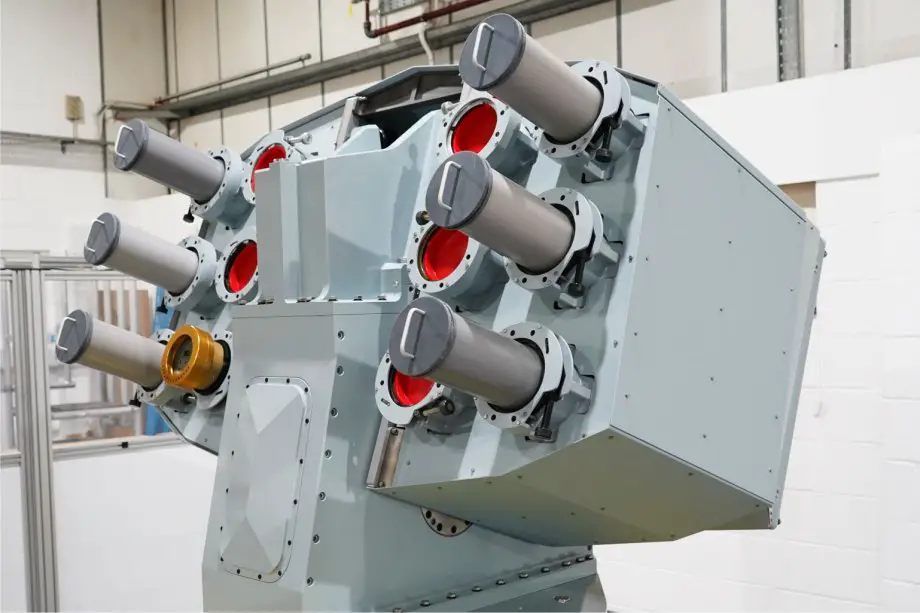According to information published by the UK MoD on March 26, 2024, DE&S has awarded a contract worth £135 million to Systems, Engineering and Assessment Ltd (SEA). This contract is focused on equipping Type 26 and Type 31 frigates, along with Type 45 destroyers, with Ancilia, a new generation of decoy launchers designed to counter hostile drones and missiles.
Follow Navy Recognition on Google News at this link
 Ancilia decoy launcher. (Picture source: SEA)
Ancilia decoy launcher. (Picture source: SEA)
Ancilia represents an advancement in countermeasures technology, moving away from traditional stationary systems to a more flexible, trainable configuration. This approach allows the system to respond swiftly and effectively to threats such as hypersonic and ballistic missiles without requiring the vessel to change its course, addressing the evolving nature of maritime threats.
The system is noted for its modular and adaptable design, capable of deploying a broad range of surface and subsurface countermeasures. It supports various 130mm NATO standard decoys and other calibres of effectors, enhancing its adaptability.
Ancilia can be integrated into existing Combat Management Systems (CMS) and is compatible with third-party Electronic Support Measures (ESM), facilitating its addition to current maritime platforms with minimal modifications needed.
Decoy launchers
Naval decoy launchers are sophisticated defense systems used by naval vessels to counter threats from missiles and torpedoes. They deploy various types of decoys to deceive and divert incoming threats away from the ship, effectively increasing its survivability in combat situations. Here are some notable examples and their functionalities:
C-Guard Decoy Launching System:
This system is designed for comprehensive self-protection against both missiles and torpedoes, offering 360° coverage. It is capable of defeating coordinated attacks with multiple threats, relying on 130 mm NATO SeaGnat compatible decoys.
The C-Guard system is known for its ease of integration with a ship's combat management system, flexibility in launching any anti-missile or anti-torpedo round regardless of manufacturer, and the ability to operate in manual, semi-automatic, or automatic modes for deploying effective countermeasures.
Its fixed launcher design ensures reliable 360° coverage without the risk of mechanical failure, and its cost-effectiveness is highlighted by low maintenance requirements and high operational availability (Terma).
Naval Group’s Counter Measure Launching System (CMLS):
Developed by the French shipbuilder Naval Group, the CMLS is a pneumatic launcher capable of deploying up to six CANTO torpedo decoys. It was designed for easy integration aboard various vessels, including the FDI frigates and can be reloaded while underway at sea. This system emphasizes flexibility, being applicable not only to Naval Group ships but also available to other shipbuilders (Naval News).
MK 53 Decoy Launching System (Nulka):
A collaboration between the United States and Australia resulted in the MK 53 DLS, a rapid response system that deploys Active Expendable Decoys (AED) to protect ships from anti-ship missiles.
Nulka, meaning 'be quick' in Australian Aboriginal dialect, is designed to counter a wide spectrum of radar-guided missiles by emitting a large, ship-like radar cross section to lure missiles away from their targets (Navy MIL).
Mark 36 SRBOC (Super Rapid Bloom Offboard Countermeasures):
This American system launches radar or infrared decoys to foil incoming anti-ship missiles. It features the Mark 137 launcher with six fixed mortar tubes, allowing for a spread of launched decoys. The Mark 36 SRBOC is integrated with the AN/SLQ-32 electronic warfare suite for automatic decoy deployment in response to missile attacks.



